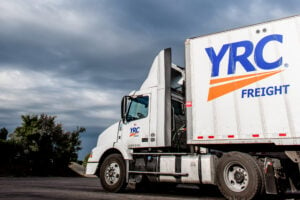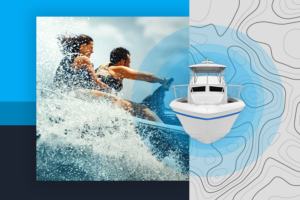*The majority of military transport is currently outsourced to contractors throughout the US. However, troop and combat equipment remains the exception.
In November 1959, a top secret reconnaissance aircraft was designed by Lockheed Corporation for the CIA to capture information from the Soviet Union and Cuba while scrambling their radar capabilities. Discretely dubbed the OXCART project, the plane would become known as the Archangel-12, or A-12. It would go on to become the world’s fastest plane, the first to break Mach 2.0, and the prototype and proof-of-concept for the more famous SR-71 aircraft.
The Move to Area 51
In 1959, as part of OXCART, a full-scale model (Article 121) of the A-12 was built for testing. The problem? The government needed to get the plane hauled from Burbank, Calif., Lockheed’s site, to Groom Lake, Nev., aka Area 51, for studies of its radar cross-section.
This was not your typical heavy haul move. Given the sensitive nature of the tactical spyplane’s capabilities, its movements were classified and veiled from all civilian and possible enemy radar. Extreme measures were taken to ensure its existence remained state secret.
While most transporters today count on their GPS devices and their favorite trip planning app, transporting of the A-12 prototype was far from simple. It began in 1959 with a road survey, including planning a route for the official A-12 transportation crew. The plane’s wideload — a whopping 35 feet wide by 105 feet long–blows away today’s 8’6” wideload regulation. So, along the route, signs were modified, trees were cut and roadside dirt removed. In some places, roadside barriers were either removed or adjusted for the wideload.
After three years of preparation and planning, the A-12 was finally ready for transport. On February 26, 1962, it left Burbank and three days of almost non-stop driving to complete the trip.
How’d They Do It?
Skunkworks engineers constructed a carriage system for the A-12 around the pre-assembled plane. The engineers assembled two steel frame boxes to transport the aircraft. A larger box framed the body of the plane and its landing gear. The safest way to carry the weight of the load securely was to transport the plane and its steel case on its landing gear. Engineers equipped the main box with a manual-drive axle due to its large size. The second, smaller box carried the removable outer wing as well as the rudders, forward fuselage section and other small pieces separately from the larger load. “Day Cabs” supplied by Lockheed carried these two boxes across the desert to Area 51.The CIA completed the journey in secrecy using these privately owned vehicles.
When the A-12 prototype made it to the testing area, CIA teams completed full assembly, performed engine test and cleared systems for flight. Lockheed Test Pilot Lou Schalk was the first to fly the prototype plane on April 26, 1962.
Meet T.D. Barnes, Area 51 Special Projects
When testing began, the CIA called on Thornton D. “TD” Barnes-Area 51 Special Projects, on a need-to-know basis to track and analyze the A-12 flights. Mr. Barnes is the current President of Roadrunners Internationale, a group of veterans whose goal is to offer an accurate accounting of the historical events related to the A-12, YF-12 and associated programs plus the early U-2 program. We caught up with Mr. Barnes and fired off a round of questions to get a better understanding of the A-12 flights.
T.D. Barnes – Roadrunners Internationale President
uShip: To start, what exactly was your role in OXCART Program? What is your role in Roadrunners Internationale?
TD Barnes: I was involved in the OXCART program in three phases. The first was a flight on a NSA/CIA Project Palladium ghost plane out of Biggs AFB to probe the Russians in Cuba into turning on their radar systems so we could determine their capability. We needed to know if the Russians would be able to shoot down the A-12 Blackbird that we intended to replace the U-2. We determined that they would be able to shoot the plane down, and never overflew Russia again in a plane. (We used satellites instead.)
The second phase of my participation was a secret radar network referred to as the Seven Sisters. Six ADC (Air Defense Command) radars “unofficially” tracked flights of the A-12 out of Groom Lake in case something happened. I was a Hypersonic Flight Support Specialist on the NASA High Range 65 miles from Groom Lake. I was cleared to track the A-12 during its velocity verification phase. (Of course, I wasn’t told what I was tracking at that time. I had no need to know.)
The third phase was performing RCS, Radar Cross Section evaluations, of the A-12 to verify its stealth capability. It was America’s first stealth plane.
I am the president of Roadrunners Internationale.
uShip: The Roadrunners Internationale article on the transportation of the A-12s includes a detailed story of this trip. Did you have a role in the transportation of these planes?
TD: I did not have a role in the transportation. We do have a few former CIA guards around who participated in the move.
uShip: When did the information about the A-12s become declassified? When were you able to publish the story on the Roadrunners Internationale website?
TD: We started publishing about the A-12 during the declassification. I worked directly with CIA in this regard. We had a common interest in getting the story from the participants in OXCART before they were all gone. The CIA had very little information on the program. During the day, we took few notes to avoid the paperwork of having it classified as Top Secret. Also, we were so compartmentalized: none of us talked to each other unless there was a need to know. The new generation at CIA had no idea what all we did.
uShip: In top secret missions such as the building, transport and testing of the A-12, how was transportation handled? Were there any transportation jobs contracted to those not in the military?
TD: The building was confined to just a few at Lockheed, CIA, and my Special Projects team assigned to Groom Lake as technical cadre. The transport used only Lockheed trucks and drivers, CIA security guards, and the California Highway Patrol, who wouldn’t have had a clue what was in the boxes. Less than 5% of the people supporting OXCART ever knew what it was for, what it did, and that the CIA was involved. Even in the CIA, one had to have OXCART assess clearance and a need to know. The project was so classified that the CIA didn’t trust the FBI to conduct security clearance investigations. Everything was handled in-house.
uShip: Have these transportation rules changed over time? Are there more military jobs contracted outside of military personnel today?
TD: Most of the transportation is contracted by “the customer.” The military is not involved other than security and base support. Most military at Groom Lake do not know what “the customer” is doing as the military does not have the need-to-know. When the CIA ran the base, the military worked for the CIA.
uShip: Did you have any involvement in the transportation of materials in and out of Area 51, aka Groom Lake, NV?
TD: Negative. The customer, Lockheed, Boeing, Northrop, etc. would provide the transportation for their item being tested. The worker transportation is contracted as well.
uShip: In an article on the building of the A-12s, it was said that the titanium used to build the aircraft was bought and shipped to California from Russia in the midst of the Cold War arms race. Is this true? Was the Russian titanium transported through the military or through a dummy company?
TD: Yes, the titanium came from Russia. I’ve never heard how it was acquired or transported. It would have been through dummy companies and to dummy addresses. That was routine for how we worked. Real names were very seldom used.
uShip: Around the time of your involvement with the OXCART Project, you worked for NASA, how did NASA’s transportation procedures compare to the Military’s?
TD: NASA’s transportation was also contracted. Most NASA activities were not classified, so general transportation was often used.
uShip: Do you think the military should contract more transportation work to outside sources?
TD: Actually, most military transportation is outsourced. Troop and combat unit movement would be the exception.
uShip: To conclude, is Area 51 really the site of aliens, or were the UFOs actually early A-12 planes?
TD: Negative on the aliens. We flew countless U-2 flights and 2,850 A-12 flights out of Groom Lake when no one knew the planes even existed. Both planes flew many times higher than conventional aircraft, so when sighted – they were UFOs. We used cover stories in case one was inadvertently sighted. If one crashed, we identified it as another type of plane and secured the area.



